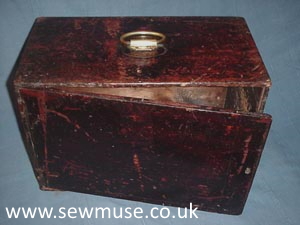| A - Z Canadian Manufacturers | New Williams Manufacturing Co. |
Charles Raymond |
Wilson, Bowman & Co. |
The Gallery | Home | Contact Us |
R. M. WANZER & Co.
Richard Mott Wanzer started manufacturing sewing machines in Canada in 1858 in a workshop on James Street, Hamilton and by 1861 the firm was producing 1000 machines per week. In the early 1860's the factory was moved to King Street, Hamilton and by 1875 over 500,000 machines had been produced. By 1889 a total of 1,500,000 Wanzer sewing machines had been produced since 1861.
In 1878 the Wanzer Company purchased the Canada Sewing Machine Company, Barton Street, Hamilton developing the site for its purpose built factory which was completed c1880 and which was capable of producing over 100,000 machines a year.
The firm seems to have traded as The Wanzer Sewing Machine Co Ltd in Great Britain and France where there were offices in London at 4 Great Portland Street (1863) and 131 Boulevard Sebastopol, Paris (1867). There is reference to a factory at 20 Hart Street, Covent Garden, London in the late 1860/early1870's but exactly what work was undertaken there is still unknown.
The Company's machines won a number of prize medals at International Exhibitions including the 1867 Exposition Universelle de Paris, The World Exposition 1873 and the Gold Medal, Centennial Medal and Diploma at the 1876 Centennial Exhibition. The Company ceased production in 1892.
MACHINES PRODUCED:
1858 The Company initially produced machines based on Singer and Wheeler & Wilson principles.
Family Shuttle
Introduced in 1862 this was the first machine to bear the Company name, it was unique in that the Company successfully put a shuttle moving in a vertical arc in a Wheeler & Wilson style machine.
Little Wanzer
Introduced in 1867 with 4000 machines being sold in the first year of production. Nearly 200,000 Little Wanzer machines were in use by 1874 & by 1876 half a million had been manufactured. The machine underwent various cosmetic improvements, very early versions have no needle bar cover, later a brass cover was produced but by the 30,000th machine this had been replaced by one which was nickel plated and which included the Patent dates May 16 & June 17 1867.
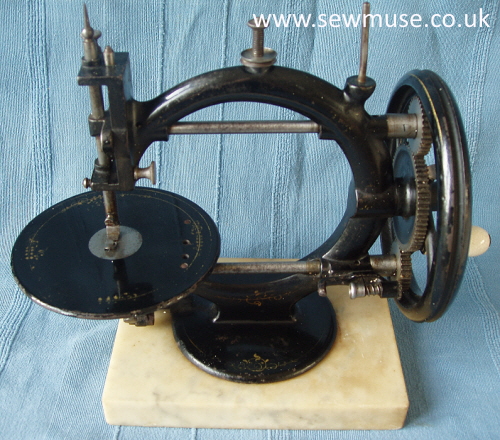
ABOVE: Little Wanzer Serial No. 7763.
This early example of the Little Wanzer dates to 1868. These early models had no provision for a needlebar cover, plain five spoke balance wheel, and simple bobbin winder. Like many early machines the hand painted decoration is heavily worn, two patent dates 16 May & 17 June 1867 are painted on the back part of the base of the machine and can just be made out.
The machine is mounted on a heavy marble slab to provide stability when sewing.
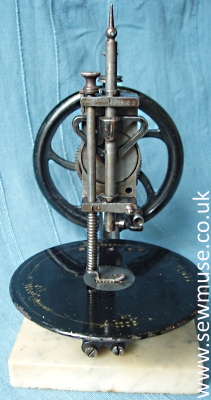
BELOW: Little Wanzer Serial No. 104404.
This later example of the Little Wanzer dates to the early 1870's. It has a nickel plated needle bar cover which bears the patent dates, serial number and the company's Time-Utilizer Trade Mark. The balance wheel is much more ornate and the machine is mounted on a wooden base and there is damage to the machines base casting where it has been clamped to a table.
On the base the name R. I. Watts & Co. can be made out along with Exeter and the first two letters of town Plymouth.
Richard I. Watts started selling sewing machines in 1859, he had premises in Bedford Street, Plymouth in the mid & late 1860's before moving to George Street. In July 1868 he opened another Depot in High Street, Exeter.
For many years the firm had agencies for some of the leading manufacturers - Grover & Baker, Elias Howe, Remington, Whight & Mann, W. F. Thomas, Wm Jones, Guelph, Jas Weir, but the only reference to Wanzer machines being supplied are adverts from 1871 & 1872. The lastest date I have for his business is 1880.
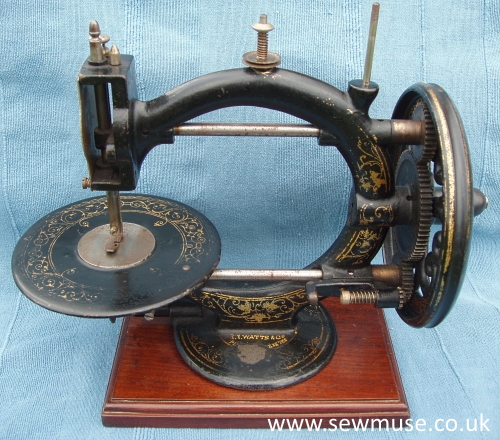
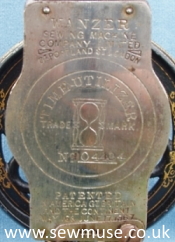
New Little Wanzer c1877 - c1880.
This was a significantly improved version of the Little Wanzer featuring a fully enclosed needle bar area incorporating a Patented take up lever. Patent dates of May 29th 1877 and December 11th 1877 appear on some versions.
NOTE: In all these versions of the Little Wanzer the shuttle moves in a vertical arc and the shuttle has to be accessed from beneath the machine.
Little Wanzer Straight Race
In the early 1880's the final version of the Little Wanzer was introduced. It had a straight shuttle race and a slide plate to access the shuttle in the cloth plate. The tension discs were mounted on top of the arm, but these late versions do not feature the Patented take up lever. It is believed production of this machine ceased in 1883.

PHOTO LEFT: Little Wanzer S.R. Serial No. 667015.
Although almost all the decals have gone 'Little Wanzer S.R.' can faintly be made out on the arm of this early 1880's machine. The S.R. standing for Straight Race, it also has the tension discs mounted vertically on top of the arm, slide plate to the front of the cloth plate and an improved bobbin winder.
The brass plate at the base of the machine has 'Time Utilizer' with an Hour Glass Trade Mark, machine Serial Number and the London address of the Company. A table clamp came with this machine.
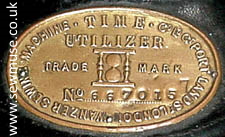
Wanzer 'A'
The early version of this machine uses a shuttle moving in a vertical arc as was used in the Little Wanzer. Produced from c1874 it was advertised as 'The Great Mechanical Success of the Age' --'The most powerful yet light running Hand Machine'.
The later version featured a straight shuttle race which was patented in 1875 and 'Shell Shuttle', the Wanzer A was still being produced in 1883.
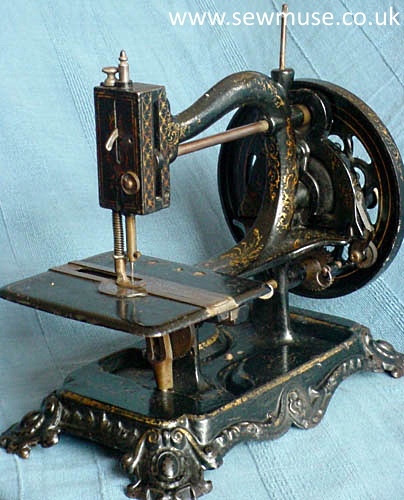
PHOTO RIGHT: Wanzer 'A' Serial No. Unknown.
This is a later version of the Wanzer 'A', with the straight shuttle race, the machine was further improved with the addition of an updated bobbin winder. The Company name & London address - Gt Portland Street London are stamped on the slide plate. WANZER, A is cast on the underneath of the cloth-plate, and the machine sits in an ornamental cast iron base.
Wanzer 'F'
A family and light manufacturing machine with reversible feed which was being produced between 1874 and 1883.
Wanzer 'D'
A Heavy Machine suitable for Manufacturers of Heavy Goods, Tailors and Outfitters although in production in 1874 it seems to have ceased before 1880.
Wanzer 'E'
A wheel feed machine which was suitable for tailoring as well as boot closing and heavy leatherwork. It is known to have been in production between 1874 and 1883.
Wanzer 'C'
The Company introduced the Wanzer 'C' 'Light Foot Family Machine' in 1880 advertising it as having 'every improvement up to 1879'. It was still being produced in 1884.
Wanzer 'B'
Patented in 1883 available in Great Britain in 1884 as a hand or treadle machine it had no gears but worked from a triple action motion which the company called "Eccentagon" and which was registered as a Trade Mark. The machine was awarded a Gold Medal at the International Health Exhibition held in 1884.
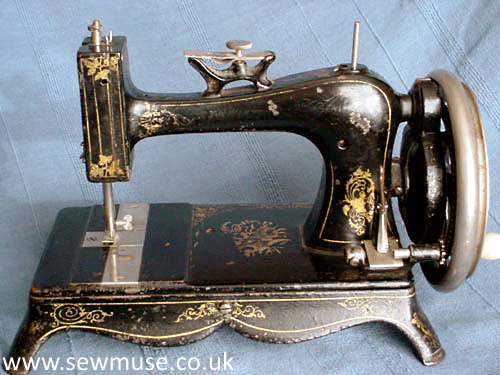
PHOTO LEFT: Wanzer 'B' Serial No. 26595.
"The Wanzer" can just be made out on the arm of this machine and the centre decal is largely intact. On the front slide plate it has "Wanzer" but almost all the rest of the engraving is worn off, only London and a patent date of 1883 remain.
It has an interesting tension arrangement and unusual bobbin winder.
This example has an ornamental cast iron base but it was available with a standard wooden one.
